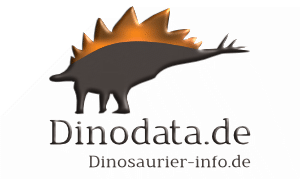Mymoorapelta maysi

Kirkland, Carpenter, 1994
Klassifizierung: Nodosauridae
Fortbewegung: quadruped
Ernährung: herbivor
Bedeutung des Namen: Schild von Mygatt Moor
Mymoorapelta war ein kleiner früher Nodosaurier, er lebte am Ende des späten Jura vor etwa 150 Millionen Jahren. Dieser Dinosaurier besaß wie sein Verwandter Ankylosaurus eine gepanzerte Hautoberfläche aus sogenannten Osteodermen und spitze, knöcherne Dornen an den Schulterblättern. Mymoorapelta ist von Teilen eines fragmentierten Schädels sowie von drei verschiedenen Teilskeletten bekannt. Er wurde nach dem Mygatt-Moore Steinbruch benannt, in dem er gefunden wurde.
Im Jahr 1982 begannen die ersten Ausgrabungen in diesem-Steinbruch. Dabei wurden Knochen von verschiedenen Dinosaurierarten, darunter Allosaurus, Apatosaurus und Camarasaurus freigelegt. Und es wurde das Skelett eines Ankylosauriers einer bis dahin noch unbekannten Art gefunden. Erst 1994 benannten und beschrieben James Kirkland und Kenneth Carpenter diesen Fund als neue Art Mymoorapelta maysi.
Höhe: 1 m
Länge: 2,7 m
Gewicht: 350 kg
Holotyp: MWC 1815
Fundort: Morrison Formation, Mygatt-Moore Quarry, Mesa County, Colorado, USA

© Dinodata.de

© kazuh

© Peter Montgomery
Weitere Informationen
Ankylosaur (Dinosauria) specimens from the Upper Jurassic Morrison Formation / James I. Kirkland, Kenneth Carpenter, Adrian P. Hunt, Rodney D. Scheetz, 1998 / Modern Geology, Vol. 23, pp. 145-177
North America's first pre-Cretaceous ankylosaur (Dinosauria) from the Upper Jurassic Morrison Formation of western Colorado / James I. Kirkland, Kenneth Carpenter, 1984 / Brigham Young University Geology Studies 40: 25-42
History and geology of the Cope’s Nipple Quarries in Garden Park, Colorado - type locality of giant sauropods in the Upper Jurassic Morrison Formation / Kenneth Carpenter, 2019 / Geology of the Intermountain West, v. 6, p. 31-53., doi: 10.31711/giw.v6.pp31-53
/ Geology of the Intermountain West, v. 6, p. 31-53., doi: 10.31711/giw.v6.pp31-53 PDF
PDF
Major bonebeds in mudrocks of the Morrison Formation (Upper Jurassic), northern Colorado Plateau of Utah and Colorado / John R. Foster, Julia B. McHugh, Joseph E. Peterson, Michael F. Leschin, 2016 / Geology of the Intermountain West, [S.l.], v. 3, p. 33-66, dec. 2016. ISSN 2380-7601 /
/ John R. Foster, Julia B. McHugh, Joseph E. Peterson, Michael F. Leschin, 2016 / Geology of the Intermountain West, [S.l.], v. 3, p. 33-66, dec. 2016. ISSN 2380-7601 / PDF
PDF
Paleoecological analysis of the vertebrate fauna of the Morrison Formation (Upper Jurassic), Rocky Mountain region, U.S.A . / John R. Foster, 2003 / New Mexico Museum of Natural History, Bulletin 23, 1-95, 2003 /
. / John R. Foster, 2003 / New Mexico Museum of Natural History, Bulletin 23, 1-95, 2003 / PDF - Teil 1 / Teil 2
PDF - Teil 1 / Teil 2
Redefining the Upper Jurassic Morrison Formation in Garden Park National Natural Landmark and vicinity, eastern Colorado: Geology of the Intermountain West / Kenneth Carpenter, Eugene Lindsey, 2019 / Geology of the Intermountain West: Geology of the Intermountain West, v. 6, p. 1-30., doi: 10.31711/giw.v6.pp1-30
/ Kenneth Carpenter, Eugene Lindsey, 2019 / Geology of the Intermountain West: Geology of the Intermountain West, v. 6, p. 1-30., doi: 10.31711/giw.v6.pp1-30 PDF
PDF
Stratigraphic Setting of Fossil Log Sites in the Morrison Formation (Upper Jurassic) near Dinosaur National Monument, Uintah County, Utah, USA / Douglas A. Sprinkel, Mary Beth Bennis, Dale E. Gray, Carole T. Gee, 2019 / Geology of the Intermountain West, v. 6, pp. 61-76, doi: 10.31711/giw.v6.pp61-76
/ Douglas A. Sprinkel, Mary Beth Bennis, Dale E. Gray, Carole T. Gee, 2019 / Geology of the Intermountain West, v. 6, pp. 61-76, doi: 10.31711/giw.v6.pp61-76 PDF
PDF
The Morrison Formation Sauropod Consensus: A freely accessible online spreadsheet of collected sauropod specimens, their housing institutions, contents, references, localities, and other potentially useful information / Emanuel Tschopp, John A. Whitlock, D. Cary Woodruff, John R. Foster, Roberto Lei, Simone Giovanardi, 2019 / PaleorXiv. October 30. doi:10.31233/osf.io/ydvra /
/ Emanuel Tschopp, John A. Whitlock, D. Cary Woodruff, John R. Foster, Roberto Lei, Simone Giovanardi, 2019 / PaleorXiv. October 30. doi:10.31233/osf.io/ydvra / PDF
PDF
What factors influence our reconstructions of Morrison Formation sauropod diversity? / D. Cary Woodruff, 2019 / Geology of the Intermountain West, v. 6, p. 93-112., doi: 10.31711/giw.v6.pp93-112
/ D. Cary Woodruff, 2019 / Geology of the Intermountain West, v. 6, p. 93-112., doi: 10.31711/giw.v6.pp93-112 PDF
PDF
- - - - -
Bildlizenzen
Größenvergleich © Dinodata.de:
 Creative Commons 4.0 International (CC BY 4.0)
Creative Commons 4.0 International (CC BY 4.0)
Skelett des Mymoorapelta © kazuh:
 Creative Commons 2.0 Generic (CC BY 2.0)
Creative Commons 2.0 Generic (CC BY 2.0)
Mymoorapelta & Ceratosaurus © Peter Montgomery:
 Creative Commons NonCommercial-ShareAlike 2.0 Generic (CC BY-NC-SA 2.0)
Creative Commons NonCommercial-ShareAlike 2.0 Generic (CC BY-NC-SA 2.0)



